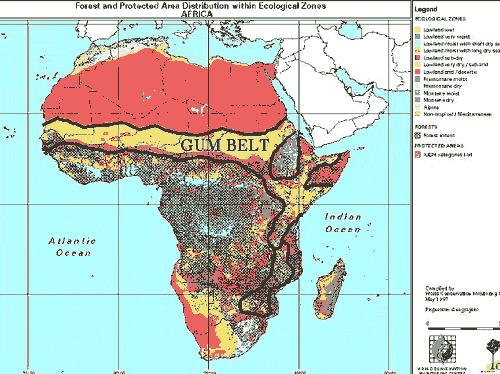Gum Arabic--A Tree Crop for Arid Lands
/
Forest Product Division
Wood and Non-wood Products Utilization Branch
Viale delle Terme di Caracalla
00100 Rome, Italy
Fax: +39-06-570-55618
E-mail: [email protected]
Home Page: http://www.fao.org/forestry/FOP/FOPW/NWFP/nwfp-e.stm
Organization:
UN Food and Agriculture OrganizationForest Product Division
Wood and Non-wood Products Utilization Branch
Viale delle Terme di Caracalla
00100 Rome, Italy
Fax: +39-06-570-55618
E-mail: [email protected]
Home Page: http://www.fao.org/forestry/FOP/FOPW/NWFP/nwfp-e.stm
Abstract
Gum Arabic is an important ingredient used in the food industry throughout the world. Production of the raw materials is primarily done in arid lands across Africa.

GUM ARABIC
- Water-soluble gum mainly used in food industry
- From trees of the genus Acacia
- A. senegal and A. seyal
- Almost all is of African origin (Sudan)
- international trade of 40.000 tonnes/year
- 4% of world hydrocolloids market (starch)
- unit value of US$ 2 -5/kg

Non-Wood Forest Products: Issues
- Dynamics of NWFP
- All "crops" once were "NWFP"
- Domestication of NWFP and related issues
- technical, economical, social, environmental
- NWFP production/ interaction with agricultural crop/ grazing systems
- NWFP as a by-/co-product of agricultural crops/agroforestry
 |  |
Main characteristics of NWFP
| Characteristics of Cultivated Production
|
 |  |
 |  |  |
| The gum is exuded from trunks, branches and twigs | ||
Constraints
- Lack of awareness (except in Sudan)
- Lack of institutional and policy support
- Lack of information on resource availability
- Irregular supply and product quality
- Use of product unknown outside the region of origin
- Risk of 'boom and burst cycle'
 | Primary cleaning and grading of gum arabic at the Gum Arabic Co. depot, El Obeid, Sudan (Photo: J.J.W. Copper) |
| Final inspection of mechanically cleaned gum arabic at the Gum Arabic Co. depot, El Obeid, Sudan (Photo: J.J.W. Copper) |  |

Opportunities
- Products of "rural poor" (+ rural employment)
- Local knowledge
- Less-destructive exploitation
- Low capital investment and technology
- Low volume (high value) products
- Market niches:
- "Bio-products"--Organic gum (Chad)
- Fair trade
